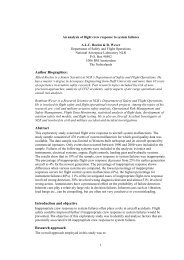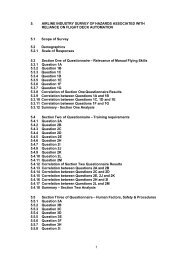Causal risk models of air transport - NLR-ATSI
Causal risk models of air transport - NLR-ATSI
Causal risk models of air transport - NLR-ATSI
Create successful ePaper yourself
Turn your PDF publications into a flip-book with our unique Google optimized e-Paper software.
The difference between singular and generic causal relations is particularly important when<br />
causation is used to determine responsibility or guilt, but that is not the purpose <strong>of</strong> the<br />
causal <strong>risk</strong> <strong>models</strong> that are subject <strong>of</strong> this thesis.<br />
The other way around, the absence <strong>of</strong> a singular cause effect relation is not sufficient to<br />
negate a generic causal relation. A 95 year old heavy smoker without health problems is not<br />
a pro<strong>of</strong> that smoking is not harmful. Yet such singular examples may be compelling and<br />
people’s faith in causal <strong>risk</strong> <strong>models</strong> may very well be eroded if they happen to know a few<br />
<strong>of</strong> such singular examples that are seemingly contradictory to the generic model relations.<br />
A <strong>risk</strong> model that not only explicitly represents failure scenarios but also success scenarios<br />
would be helpful in this respect.<br />
3.5. Strong and weak causal relations<br />
Another potential source <strong>of</strong> confusion is the difference between weak and strong<br />
relationships. In some cases, cause effect relations can be considered strong, in the sense<br />
that the occurrence <strong>of</strong> the cause will always result in the effect. An example is the cause<br />
‘empty fuel tank’ and the effect ‘car does not start’. Other cause-effect relations may be<br />
weaker. An example is the cause ‘cigarette smoking’ and the effect ‘lung cancer’. The fact<br />
that someone has a habit <strong>of</strong> smoking cigarettes does not always results in the person<br />
developing lung cancer, although the probability for lung cancer is greatly increased when<br />
someone smokes. The ‘weakness’ <strong>of</strong> the cause-effect relation depends on the conditional<br />
probability P (effect | cause). If this conditional probability is 1 or close to 1 (as in the case<br />
<strong>of</strong> the car example) the cause-effect is strong. If the conditional probability is close to 0, the<br />
relation is weak. A weak statistical association should however not be taken as indicating a<br />
non-causal relationship. Weak statistical associations may be seen for instance if an effect<br />
is common and there are numerous possible causal pathways towards that effect.<br />
A weak cause-effect relationship does not require high probabilities to be acceptable. What<br />
is important is the statistical relevance <strong>of</strong> the relationship. When a certain drug increases the<br />
recovery rate from 5% to 10% it is the statistical significance <strong>of</strong> the difference between the<br />
treatment group and the control group that determines whether we accept that there is pro<strong>of</strong><br />
that the drug is working.<br />
3.6. The beginning and the end <strong>of</strong> causation<br />
An obvious question to ask when the cause <strong>of</strong> an effect has been determined is “What<br />
causes the cause?” This question is not only interesting from a philosophical point <strong>of</strong> view<br />
but is also relevant for accident prevention. If the cause <strong>of</strong> an accident is determined to be<br />
pilot fatigue this is interesting to know but in order to prevent similar occurrences from<br />
happening we usually need to know what caused the fatigue, i.e. what caused the cause 14 .<br />
Only then are we able to take measures to safeguard against similar events. If we are<br />
sufficiently clever and persevering we can continue determining the causes <strong>of</strong> causes right<br />
up to the big bang that created the universe. In a similar fashion we can think <strong>of</strong> the effects<br />
<strong>of</strong> effects. In the event <strong>of</strong> an <strong>air</strong>craft crash an immediate effect may for instance be the<br />
release <strong>of</strong> toxic substances into the atmosphere if the <strong>air</strong>craft was carrying hazardous<br />
materials as cargo. This may then cause, perhaps even years later, health problems for<br />
people exposed to those materials. <strong>Causal</strong> chains never really end, but for practical<br />
purposes the model must.<br />
14<br />
Unless we can detect the presence <strong>of</strong> this proximal cause and take preventive measures<br />
on it, i.e. in this case detect fatigued pilots and prevent them from flying.<br />
29




